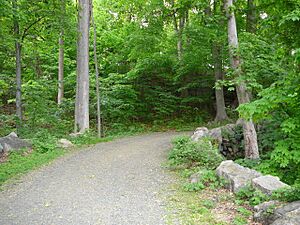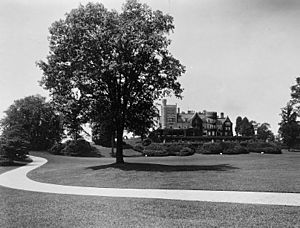Rockefeller State Park Preserve facts for kids
Rockefeller State Park Preserve is a beautiful state park located in Mount Pleasant, New York. It sits near the Hudson River in Westchester County. Many people visit the park to enjoy activities like horse-riding, walking, jogging, and running. It's also a great spot for bird-watching and fishing.
The park has an interesting history. The Rockefeller family gave this land to New York State over many years, starting in 1983. A part of the park, called the Rockwood Hall property, is right next to the Hudson River. This area used to be the private home of William Rockefeller. It became a New York state park in the early 1970s. In 2018, the park was officially added to New York's list of historic places.
Contents
What Makes Rockefeller State Park Special?
Rockefeller State Park Preserve is known for its amazing wildlife and beautiful views. The National Audubon Society has even named it an Important Bird Area. This means it's a very important place for birds, with over 180 different kinds of birds living there!
Exploring the Park's Trails and Nature
The park has 55 miles (89 km) of special paths called carriage roads. These paths let visitors explore all the different parts of the park. You can see open fields, thick forests, winding streams, and wet areas. There's also a lovely 24-acre (97,000 m2) lake called Swan Lake. The whole park covers about 1,771-acre (7.17 km2) of land.
The park is next to the Old Croton Aqueduct State Historic Park and Sleepy Hollow Cemetery. It also connects to large private lands owned by the Rockefeller family. These private trails are also open for people to use. Many of these trails were designed by John D. Rockefeller (the first one) and his family. You can get to these trails from Sleepy Hollow Road and Bedford Road/Route 448 in Sleepy Hollow.
Art and Farming Near the Park
Inside the park's Visitor Center, there's a small art gallery. It often shows paintings and photos made by local artists.
Stone Barns Center for Food & Agriculture is a farm and education center nearby. It teaches people about growing food in a way that helps the environment. You can walk to Stone Barns from the preserve. Sometimes, pigs and cows from Stone Barns graze in the park's woods.
Visiting the Park
Rockefeller State Park Preserve is open every day of the year, from sunrise to sunset. The park office is open from 9:00 a.m. to 4:30 p.m. There is a $6.00 fee to park your car.
Rockwood Hall: A Historic Part of the Park
Rockwood Hall is a special section of the state park. It was once the home of William Rockefeller, who was the brother of John D. Rockefeller. Laurence Rockefeller gave this land to New York State in 1999 so it could become part of the park.
The Story of Rockwood Hall Mansion
Before the Rockefellers, other people owned the land. One early owner was Alexander Slidell Mackenzie, who lived there from 1840 to 1848. Later, Edwin Bartlett bought the property. He built a large castle called Rockwood. It was made of stone from the area and looked like an English Gothic castle.
Bartlett sold the house to his business partner, William Henry Aspinwall, in 1860. Aspinwall used it as his summer home. He made the house and land even better, buying enough land to make his estate 200 acres (81 ha). After he passed away in 1875, his son Lloyd Aspinwall lived there until 1886.
Then, William Rockefeller bought the property for $150,000. He made his property much bigger, to about 1,000 acres (400 ha). He either fixed up or completely rebuilt the castle. The new house had 204 rooms and was huge, measuring 174 by 104 feet. At that time, it was the second-largest private house in the U.S., only smaller than the Biltmore mansion in North Carolina. The mansion was later torn down in the 1940s after being empty for some time.
The land at Rockwood Hall has been used as part of the park since the 1970s. This is when Laurence Rockefeller first let New York State use the estate as a park.




